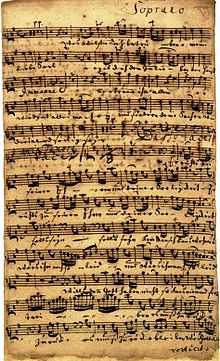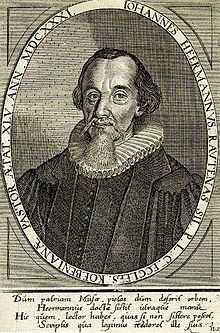Was willst du dich betrüben, BWV 107
| Was willst du dich betrüben | |
|---|---|
| BWV 107 | |
| Chorale cantata by J. S. Bach | |
 Soprano part for the cantata | |
| Occasion | Seventh Sunday after Trinity |
| Performed | 23 July 1724 – Leipzig |
| Movements | 7 |
| Chorale | Was willst du dich betrüben |
| Vocal |
|
| Instrumental |
|
Was willst du dich betrüben (Why do you want to distress yourself), [1] BWV 107, is a church cantata by Johann Sebastian Bach. He composed it in Leipzig for the seventh Sunday after Trinity and first performed it on 23 July 1724. The chorale cantata is based on the unchanged words of Johann Heermann's chorale in seven stanzas Was willst du dich betrüben (1630).
History and words
Bach composed the chorale cantata in Leipzig for the Seventh Sunday after Trinity.[2] The prescribed readings for the Sunday are from the Epistle to the Romans, "the wages of sin is death; but the gift of God is eternal life" (Romans 6:19–23), and from the Gospel of Mark, the feeding of the 4000 (Mark 8:1–9).
The cantata is based on Johann Heermann's hymn in seven stanzas, "Was willst du dich betrüben" (1630), which is focused on trust in God, even when facing adversaries including the devil.[3] Trust in God is also a theme of the Gospel. Unusual for a chorale cantata of the second cycle is the fact that the text is not changed in the middle movements, but kept "per omnes versus" (for all stanzas). The middle movements are, however, composed as a recitative and four arias. The treatment was decidedly old-fashioned in Bach's time. He had used it once much earlier in Christ lag in Todes Banden, BWV 4 (1707), and then again later, as in Gelobet sei der Herr, mein Gott, BWV 129 (1726), though it was not repeated during the second cycle.[2] John Eliot Gardiner assumes that Bach imposed this restriction on himself, as he had done with the restriction to place the cantus firmus in soprano, alto, tenor and bass in the first four cantatas of the cycle. Gardiner comments on the "seventeenth-century design" of composing the unchanged chorale text, compared to settings of Stölzel, Telemann and Graupner:
But only Bach is prepared to make life consistently difficult for himself, as here, for example, by choosing to incorporate verbatim all seven stanzas of a rather obscure chorale by Johann Heermann from 1630. … Bach rises to the challenge: to overcome the limitations of being confined to a rigidly structured hymn without monotony or repetitiveness.[4]
The chorales in Heermann's 1630 publication Devoti musica cordis (Music of a devoted heart), which also included "Herzliebster Jesu, was hast du verbrochen", the first chorale in Bach's St Matthew Passion, have been described as "the first in which the correct and elegant versification of Opitz was applied to religious subjects, … distinguished by great depth and tenderness of feeling, by an intense love of the Saviour, and earnest but not self-conscious humility".[5]
Bach first performed the cantata, the seventh cantata of his second annual cycle, on 23 July 1724.[2]
Scoring and structure
The cantata in seven movements is scored for three vocal soloists (soprano, tenor, and bass), a four-part choir, corno da caccia, two flauti traversi, two oboes d'amore, two violins, viola and basso continuo.[2]
- Chorale: Was willst du dich betrüben
- Recitative (bass): Denn Gott verlässet keinen
- Aria (bass): Auf ihn magst du es wagen
- Aria (tenor): Wenn auch gleich aus der Höllen
- Aria (soprano): Er richts zu seinen Ehren
- Aria (tenor): Drum ich mich ihm ergebe
- Choral: Herr, gib, daß ich dein Ehre
Music

The opening chorus is a chorale fantasia, the vocal part embedded in an independent concerto of the instruments. The cantus firmus on the melody of "Von Gott will ich nicht lassen"[6] is in long notes, partly embellished, in the soprano and horn; the lower voices are mostly set in homophony. The lines of the chorale are not rendered separately, but accenting the bar form (Stollen–Stollen–Abgesang) of the text, 1 and 2 are combined, 3 and 4 are combined, 5 is single and 6 to 8 are combined. The scoring is rich in woodwinds.[2]
The only recitative is accompanied by the oboes d'amore, shows an extended melisma on the word "Freuden" (joy) and culminates in an arioso in the final line, with a melisma on "retten" (rescue).[4] The following four stanzas are composed as arias,[7] not as the typical da capo arias, but mostly in two parts, due to the bar form of the poetry.[2] Bach achieves variation by changing voice type, key and time signature. He also varies the mode, alternating major and minor keys, expresses different Affekts, and he successfully "blurs" the bar form of the stanzas.[4]
The first aria depicts a "hunting scene" for bass and strings. Bach plays on the double meaning of the German word "erjagen", which in the text has the sense "achieve by great exertion", but he expresses the word's literal meaning ("to hunt") by an "outrageous hunting call trill" of the bass. The second aria for tenor and continuo begins with strong words on Satan as an enemy: "Wenn auch gleich aus der Höllen / der Satan wollte sich / dir selbst entgegenstellen / und toben wider dich" ("Even if, out of hell, Satan wishes to set himself against you, and vent his rage on you").[1] The music is termed by Gardiner "a vivid pen-portrait of Satan and his wiles, delivered with typically Lutheran relish". The rhythm alternates between 6/8 and 3/4 one measure to the next, but the change is irregular and unpredictable. The bass line (marked "organo e continuo") is "extravagantly animated and angular. Albert Schweitzer likens it to the contortions of a huge dragon".[4]
The third aria for soprano and the two oboes d'amore begins with an embellished version of the chorale tune, and the last line quotes the tune exactly on the words "was Gott will, das geschicht" ("What God wants, that happens").[1] The fourth aria is scored for tenor, the flutes in unison and muted violin.[4]
The closing chorale is set in four parts for the voices, but embedded in a rich orchestral Siciliano concerto. The lines of the chorale are grouped as in the first stanza, again highlighting line 5, "O Vater, Sohn und Geist" ("Oh Father, Son and Spirit") as a miniature doxology.[2][7]
Recordings
- Die Bach Kantate Vol. 43, Helmuth Rilling, Gächinger Kantorei, Bach-Collegium Stuttgart, Arleen Augér, Aldo Baldin, John Bröcheler, Hänssler 1979
- J.S. Bach: Das Kantatenwerk – Sacred Cantatas Vol. 6, Gustav Leonhardt, Knabenchor Hannover, Collegium Vocale Gent, Leonhardt-Consort, soloist of the Knabenchor Hannover, Kurt Equiluz, Max van Egmond, Teldec 1980
- J.S. Bach: Cantatas, Philippe Herreweghe, Collegium Vocale Gent, Agnès Mellon Howard Crook, Peter Kooy, Virgin Classics 1991
- Bach Edition Vol. 11 – Cantatas Vol. 5, conductor Pieter Jan Leusink, Holland Boys Choir, Netherlands Bach Collegium, Ruth Holton, Nico van der Meel, Bas Ramselaar, Brilliant Classics 1999
- J.S. Bach: Complete Cantatas Vol. 12, Ton Koopman, Amsterdam Baroque Orchestra & Choir, Lisa Larsson, Christoph Prégardien, Klaus Mertens, Antoine Marchand 2000
- J.S. Bach: Cantatas Trinity Cantatas 4 Ansbach/Haddington For the 6th Sunday after Trinity For the 7th Sunday after Trinity, John Eliot Gardiner, Monteverdi Choir, English Baroque Soloists, Katharine Fuge, Kobie van Rensburg, Stephan Loges, Archiv Produktion 2000
- J.S. Bach: Cantatas Vol. 23 – Cantatas from Leipzig 1724, Masaaki Suzuki, Bach Collegium Japan, Yukari Nonoshita, Makoto Sakurada, Peter Kooy, BIS 2002
References
- ↑ 1.0 1.1 1.2 Dellal, Pamela. "BWV 107 – "Cantata BWV 107 Was willst du dich betrüben"". Emmanuel Music. Retrieved 21 July 2014.
- ↑ 2.0 2.1 2.2 2.3 2.4 2.5 2.6 Dürr, Alfred (1981). Die Kantaten von Johann Sebastian Bach (in German) 1 (4 ed.). Deutscher Taschenbuchverlag. pp. 373–376. ISBN 3-423-04080-7.
- ↑ "Was willst du dich betrüben / Text and Translation of Chorale". bach-cantatas.com. 2006. Retrieved 1 August 2011.
- ↑ 4.0 4.1 4.2 4.3 4.4 John Eliot Gardiner (2009). "For the Seventh Sunday after Trinity / St Mary's, Haddington" (PDF). bach-cantatas.com. p. 13. Retrieved 1 August 2011.
- ↑ "Johann Heermann". ccel.org. 2006. Retrieved 3 August 2011.
- ↑ "Chorale Melodies used in Bach's Vocal Works / Von Gott will ich nicht lassen". bach-cantatas.com. 2006. Retrieved 1 August 2011.
- ↑ 7.0 7.1 Mincham, Julian (2010). "Chapter 8 BWV 107 Was willst du dich betrüben? / Why so much grief?". jsbachcantatas.com. Retrieved 23 July 2014.
Sources
- Was willst du dich betrüben, BWV 107: Scores at the International Music Score Library Project
- Was willst du dich betrüben BWV 107; BC A 109 / Chorale cantata Leipzig University
- Cantata BWV 107 Was willst du dich betrüben history, scoring, sources for text and music, translations to various languages, discography, discussion, bach-cantatas website
- Was willst du dich betrüben history, scoring, Bach website (German)
- BWV 107 Was willst du dich betrüben English translation, University of Vermont
- BWV 107 Was willst du dich betrüben text, scoring, University of Alberta
| ||||||||||
|